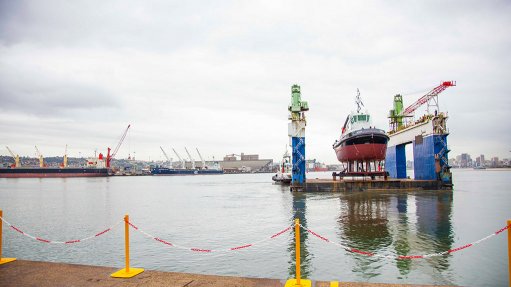
The first tugboat of Transnet National Ports Authority’s (TNPA’s) R1.4-billion tug building programme was launched at the Durban premises of contractor Southern African Shipyards on Thursday.
The 31-m-long Mvezo, named after late President Nelson Mandela’s birth town, would be handed over to the Port of Port Elizabeth in February 2016. The handover of more tugboats would be undertaken every three months until the last tugboat was launched in early 2018.
“This is the largest single contract TNPA has ever awarded to a South African company for the building of harbour craft. This demonstrates that the country has the expertise to compete in the global shipbuilding industry and to use the maritime economy to unlock the economic potential of South Africa, in line with government’s Operation Phakisa [Oceans Economy] initiative,” TNPA CEO Richard Vallihu commented.
The tug building project started in August 2014 and would provide a significant boost to the local economy over its 42-month lifespan. Given the project’s tight deadlines, five tugs would be under construction at the same time.
Two tugs each would be allocated to the Ports of Durban, Richards Bay and Port Elizabeth, while Saldanha, which handled the largest carriers, would receive three tugs.
TNPA marine operations senior manager Eugene Rappetti noted that TNPA currently had 29 tugs in service nationally, but the requirement for bigger, strong tugboat fleets had increased in line with bigger commercial vessels calling at South African ports more frequently.
“TNPA’s new fleet will have a 70 t bollard pull, while the older tugs have 32.5 t to 40 t pulls. The increased bollard pull of these new-generation tugs meets international standards and they also feature the latest global technology,” he pointed out.
The tugs used Voith Schneider propulsion, which eased manoeuvrability and resulted in an ability to almost instantaneously change direction and thrust, while guiding large vessels safely into the ports.
Subcontractors on the project included Barloworld Equipment, Siemens, Voith Schneider, as well as local contractors Bradgary Marine Shopfitters.
Southern African Shipyards CEO Prasheen Maharaj highlighted that 500 direct and 3 500 indirect jobs were created through the project.
“We have also committed to ensuring that each tug has a minimum 60% locally manufactured components, while partnering with international companies on the remaining aspects that cannot be manufactured here - for example, the engines and propulsion units,” he said.
He added that the intention was to increase local content and spread the benefits of the project to empowered suppliers and women- and youth-owned businesses.
“Ultimately, South Africa will achieve a socioeconomic benefit of more than R800-million as a result of the supplier development plan attached to the contract,” he pointed out.
In addition, a number of national and international training and development opportunities were being created for local employees, with TNPA set to send employees to Germany for training on the new propulsion units. They would also receive training locally for four to six weeks.
Rappetti added that TNPA had a significant training programme in place for engineering and deck cadets to ensure there were skilled people to operate the vessels.